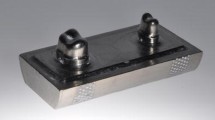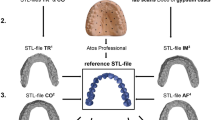Abstract
Objectives
With direct and indirect digitalisation, two access points to CAD/CAM-generated restorations are available. The aim of this study was to compare the accuracy of the single steps of both approaches by comparing construction datasets using a new methodology.
Material and method
Twelve test datasets were generated in vitro (1) with the Lava Chairside Oral Scanner (COS) (2) by digitizing polyether impressions (IMP) and (3) by scanning the referring gypsum cast by the Lava Scan ST laboratory scanner (ST) at a time. Using an inspection software, these datasets were superimposed by a best fit algorithm with the reference dataset (REF), gained from industrial computed tomography, and divergences were analysed.
Results
On the basis of average positive and negative deviations between test- and REF datasets, it could be shown that direct digitalisation accomplished the most accurate results (COS, 17 μm/−13 μm; SD ± 19 μm), followed by digitized polyether impression (IMP, 23 μm/−22 μm; SD ± 31 μm) and indirect digitalisation (ST, 36 μm/−35 μm; SD ± 52 μm). The mean absolute values of Euclidean distances showed the least values for COS (15 μm; SD ± 6 μm), followed by IMP (23 μm; SD ± 9 μm) and ST (36 μm; SD ± 7 μm). The mean negative and mean absolute values of all groups were significantly different. Comparing the mean positive values of the groups, IMP and COS (p = 0.082) showed no significant difference, whereas ST and COS, and ST and IMP exhibited statistically significant differences.
Conclusions
Within the limitations of this in vitro study, the direct digitalisation with Lava C.O.S. showed statistically significantly higher accuracy compared to the conventional procedure of impression taking and indirect digitalisation.
Clinical relevance
Within the limitations of this study, the method of direct digitalisation seems to have the potential to improve the accuracy of impressions for four-unit FDPs.






Similar content being viewed by others
References
Miyazaki T, Hotta Y, Kunii J, Kuriyama S, Tamaki Y (2009) A review of dental CAD/CAM: current status and future perspectives from 20 years of experience. Dent Mater J 28:44–56
DIN 13995: 2010‐02. Dentistry‐Terminology of process‐chain for CAD/CAM‐Systems. (NADENT: NA 014‐00‐05‐06 AK)
Beuer F, Schweiger J, Edelhoff D (2008) Digital dentistry: an overview of recent developments for CAD/CAM generated restorations. Br Dent J 204:505–511
Quaas S, Rudolph H, Luthardt RG (2007) Direct mechanical data acquisition of dental impressions for the manufacturing of CAD/CAM restorations. J Dent 35:903–908
Rubel BS (2007) Impression materials: a comparative review of impression materials most commonly used in restorative dentistry. Dent Clin N Am 51:629–642
Persson AS, Andersson M, Oden A, Sandborgh-Englund G (2008) Computer aided analysis of digitized dental stone replicas by dental CAD/CAM technology. Dent Mater 24:1123–1130
Haim M, Luthardt RG, Rudolph H, Koch R, Walter MH, Quaas S (2009) Randomized controlled clinical study on the accuracy of two-stage putty-and-wash impression materials. Int J Prosthodont 22:296–302
Endo T, Finger WJ (2006) Dimensional accuracy of a new polyether impression material. Quintessence Int 37:47–51
Christensen GJ (2008) The challenge to conventional impressions. J Am Dent Assoc 139:347–349
Al-Bakri IA, Hussey D, Al-Omari WM (2007) The dimensional accuracy of four impression techniques with the use of addition silicone impression materials. J Clin Dent 18:29–33
DIN ISO 5725‐1: 1997‐11. Accuracy (trueness and precision) of measurement methods and results‐Part 1: General prinicples and definitions (ISO 5725‐1:1994)
Steinhäuser-Andresen S, Detterbeck A, Funk C, Krumm M, Kasperl S, Holst A, Hirschfelder U (2011) Pilot study on accuracy and dimensional stability of impression materials using industrial CT technology. J Orofac Orthop 72:111–124
Ender A, Mehl A (2011) Full-arch scans: conventional versus digital impressions—an in-vitro study. Int J Comput Dent 14:11–21
State of industry (2000) Lab Management Today 16:9–15
Mehl A, Ender A, Mörmann W, Attin T (2009) Accuracy testing of a new intraoral 3D camera. Int J Comput Dent 12:11–28
Luthardt RG, Loos R, Quaas S (2005) Accuracy of intraoral data acquisition in comparison to the conventional impression. Int J Comput Dent 8:283–294
Christensen GJ (2008) Will digital impressions eliminate the current problems with conventional impressions? J Am Dent Assoc 139(6):761–763
Christensen GJ (2005) The state of fixed prosthodontics impressions: room for improvement. J Am Dent Assoc 136:343–346
Güth JF, Keul C, Beuer F, Edelhoff D (2011) Untersuchung zur Reproduzierbarkeit und Genauigkeit der 3D-Ausrichtung zum Vergleich von STL-Datensätzen. Oral presentation #33. DGPro-Jahrestagung, Hamburg, May 14
Syrek A, Reich G, Ranftl D, Klein C, Cerny B, Brodesser J (2010) Clinical evaluation of all-ceramic crowns fabricated from intraoral digital impressions based on the principle of active wavefront sampling. J Dent 38:553–559
Acknowledgments
The authors like to thank Mr. Michael Krumm from Development Center X-ray Technology EZRT of Fraunhofer IIS in Fürth for conducting the CT measurements, postprocessing and the support during this study.
Conflict of interest
The authors declare that they have no conflict of interest.
Author information
Authors and Affiliations
Corresponding author
Rights and permissions
About this article
Cite this article
Güth, JF., Keul, C., Stimmelmayr, M. et al. Accuracy of digital models obtained by direct and indirect data capturing. Clin Oral Invest 17, 1201–1208 (2013). https://doi.org/10.1007/s00784-012-0795-0
Received:
Accepted:
Published:
Issue Date:
DOI: https://doi.org/10.1007/s00784-012-0795-0




